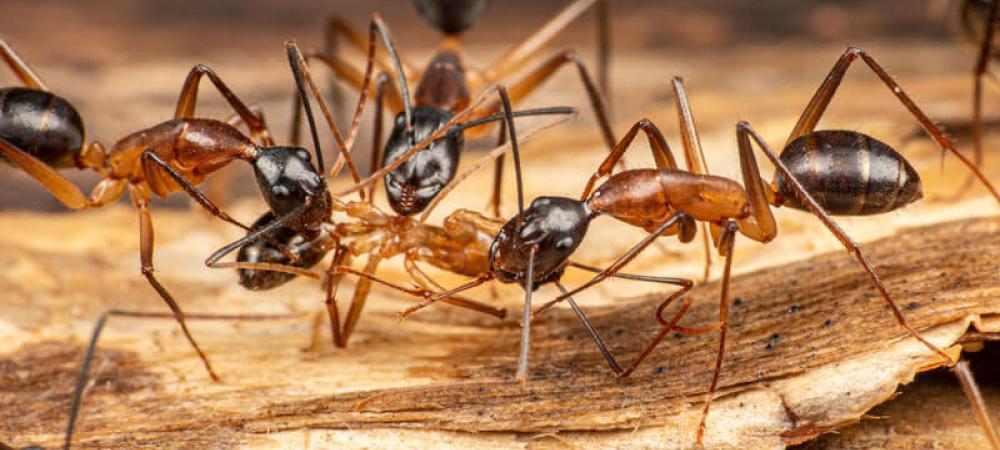How to Get Rid of Carpenter Ants

Carpenter ants are a common pest in Arizona and can be found in many areas throughout the state. These ants are larger than most other ant species and are typically black or reddish-brown. Carpenter ants get their name from their ability to excavate wood to create their nests, which can, unfortunately, cause damage to your home. So how do you get rid of them?
Getting Rid of Carpenter Ants
Over time, a carpenter ant infestation can cause significant damage to a home or property if left untreated. This is why it's important to address a carpenter ant infestation as soon as possible to prevent further damage and protect your property.
Destroy The Nest
Finding carpenter ant nests can be difficult since they are usually located inside walls or floors. There are several ways to destroy a carpenter ant nest, but the most effective method will depend on the location and size of the nest. Here are some common methods:
- Bait stations: Bait stations can be effective in controlling carpenter ant infestations. The ants carry the bait back to their nest, which can destroy the entire colony. However, this method may take some time to be effective and may not work for all infestations.
- Insecticides: Insecticides can kill carpenter ants directly or create a barrier around the infested area to prevent ants from entering or leaving the nest. It's important to use insecticides carefully and follow the manufacturer's instructions to avoid harm to humans or pets.
- Vacuuming: If the carpenter ant nest is small and accessible, vacuuming can effectively remove the ants and their nest. Make sure to dispose of the vacuum bag immediately to prevent the ants from returning.
- Professional Pest Control: If the infestation is large or the nest is difficult to locate, it's best to consult a professional pest control company specializing in carpenter ant infestations. They can use specialized tools and techniques to locate and destroy the nest, and provide ongoing maintenance to prevent future infestations.
Make Homemade Bait
While there is a lot of commercial carpenter ant bait available, there are also several homemade baits that you can try. Here are a few options:
- Borax and Sugar Bait: Mix equal parts of borax and sugar in a small container and place it near the ant trails or areas of ant activity. The sugar will attract the ants, and the borax will act as a poison when they consume it.
- Baking Soda and Powdered Sugar Bait: Mix equal parts baking soda and powdered sugar in a small container and place it near the ant trails or areas of ant activity. The sugar will attract the ants, and the baking soda will cause a reaction in their digestive systems that can be lethal.
- Vinegar and Water Spray: Mix equal parts vinegar and water in a spray bottle and spray the solution directly onto the ants or areas of ant activity. The acidity of the vinegar can help repel the ants and disrupt their scent trails.
Remove Nest Opportunities
One way to prevent carpenter ants from moving into your home is by removing nesting opportunities. Here are some ways to prevent nests around your home:
- Remove wood debris
- Fix leaks and moisture issues
- Trim trees and shrubs
- Seal cracks and crevices
- Store food properly
Use Store-Bought Insecticides
Store-bought insecticides work very well to control carpenter ant infestations. However, the downside to commercial insecticides is that they can be toxic to humans and pets. The best time to spray for carpenter ants is in the evening when the ants are most active and when there is less chance of human or pet exposure.
Eliminate Standing Water
Eliminating standing water is important in preventing carpenter ant infestations, as carpenter ants are attracted to moist environments. Here are some ways to eliminate standing water around your home:
- Fix leaks: If you have any leaks or water damage in your home, make sure to fix them as soon as possible.
- Clear gutters: Regularly clear your gutters and downspouts to prevent water from collecting around your home's foundation.
- Fill in low spots: Fill in any spots where water may collect in your yard.
- Ensure proper drainage: Ensure water from downspouts and sump pumps is directed away from your home's foundation.
- Store containers upside down: Store containers, such as buckets or flower pots, upside down to prevent water from collecting inside.
Carpenter Ant Damage
While carpenter ants do not eat wood the way termites do, they can still cause damage to structures over time. As they excavate wood to create their nests, they weaken the structural integrity of the wood.
Signs of Carpenter Ants in the House
It's important to spot the signs of carpenter ant infestations before too much damage is done to your home or property. Addressing an infestation early on can save you money and hassle in the long run. Here are some common signs of carpenter ant infestations to look out for:
- Sawdust or wood shavings
- Rustling sounds
- Piles of ant debris
- Ant trails
- Holes in wood
If you notice any of these signs, addressing the infestation as soon as possible is important to prevent further damage. Contacting a professional pest control company can help you identify the extent of the infestation and develop an effective treatment plan.
What Do Carpenter Ants Eat?
Many people ask: Do carpenter ants eat wood? While carpenter ants do not actually eat wood, their nesting habits can still cause significant damage to structures over time. Carpenter ants primarily feed on other insects and honeydew produced by aphids and other plant-sucking insects. They may also feed on sugary substances like nectar and fruit juices.
Call Greenleaf for Professional Ant Control
If you're dealing with a carpenter ant infestation in Arizona and need professional help, Greenleaf Pest Control can provide effective ant control solutions to protect your home or property. Our trained technicians have the knowledge and experience to identify the source of the infestation, locate the nests, and implement an appropriate treatment plan to eliminate the problem. Contact us today!
Frequently Asked Questions
Do Carpenter Ants Bite?
Yes, carpenter ants can bite, but generally only if they feel threatened or provoked. Carpenter ant bites can be painful and cause slight swelling or redness in the affected area. However, carpenter ant bites are generally not considered dangerous to humans, as they do not transmit diseases or venom.
Do Carpenter Ants Have Wings?
Yes, some species of carpenter ants have wings. These flying carpenter ants are known as "swarmers" responsible for mating and starting new colonies. During the spring or summer, winged carpenter ants will leave their colony and take flight to mate with other winged ants. Once they have mated, the male ants die, and the female ants shed their wings and begin searching for a suitable nesting site to start a new colony. The presence of winged carpenter ants can indicate an established colony nearby.
How Big Are Carpenter Ants?
Carpenter ants can vary in size depending on the species, but on average, they are typically larger than other common ant species. Worker ants, the most commonly seen in a colony, can range from ¼ to ½ inch long. The queens, responsible for laying eggs and reproducing, are generally larger than the workers and can be up to 1 inch long. Males responsible for mating with the queen are smaller than the workers and can range from ¼ inch to ¾ inch in length.





